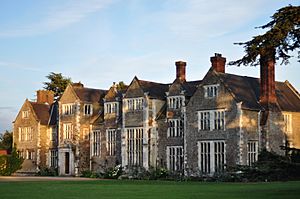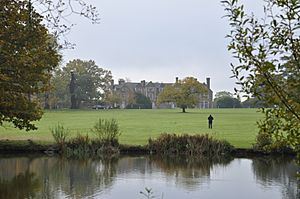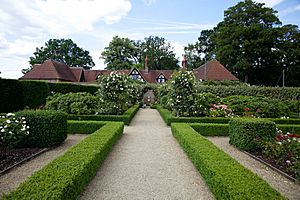Loseley Park facts for kids
Quick facts for kids Loseley Park |
|
|---|---|
 |
|
| Type | Manor house |
| Location | Littleton Lane, Artington, Surrey, England |
| OS grid reference | SU 97495 47149 |
| Built | 1568 |
| Architectural style(s) | Tudor |
| Owner | More-Molyneux family |
|
Listed Building – Grade I
|
|
| Official name: Loseley House | |
| Designated | 18 February 1958 |
| Reference no. | 1029573 |
| Lua error in Module:Location_map at line 420: attempt to index field 'wikibase' (a nil value). | |
Loseley Park is a grand old manor house located about 3 miles (4.8 km) southwest of Guildford in Surrey, England. It's near a small village called Littleton. This amazing estate has been owned by the same family, the More-Molyneux family, since the early 1500s.
The house you see today was built for Sir William More. It's considered a Grade I listed building, which means it's a very important historical site. Loseley was even mentioned in the famous Domesday Book of 1086, which was a big survey of England ordered by William the Conqueror. Today, Loseley Park is still home to the More-Molyneux family and is open for visitors to explore. You can even have weddings in its old 17th-century barn!
Contents
Exploring Loseley House
The main house at Loseley Park was built between 1562 and 1568. The builders used stone from the nearby ruins of Waverley Abbey. The new house was needed because Elizabeth I, the Queen of England, thought the old house wasn't big enough for her to visit! She asked for a larger one to be built.
The Great Hall: A Royal Welcome
The Great Hall is the most important room in the house. It has beautiful wooden panels that came from Henry VIII's Nonsuch Palace. You can also see a special balcony called a minstrel's gallery, where musicians might have played. Look out for amazing carvings by a famous artist named Grinling Gibbons. There are also portraits of kings, queens, and the family who lived here.
Special Rooms and Royal Guests
The drawing room has a fancy gold ceiling that was made especially for King James I when he visited. There's also a huge fireplace made of chalk, designed by the famous artist Hans Holbein. Above the library fireplace, carvings from 1570 celebrate one of Queen Elizabeth I's visits.
Sir William More's room has a beautiful 18th-century mirror from Vauxhall. Two bedrooms are called the King's Room and the Queen's Room. These were used by King James I and Queen Elizabeth I themselves! The house also has one of the very few paintings of Anne Boleyn, Henry VIII's second wife.
Discovering Loseley's Gardens
Loseley Park has a wonderful walled garden, designed by the famous garden expert Gertrude Jekyll. This garden is divided into different "rooms," each with its own special theme. The garden was updated starting in 1993 and 1994.
Garden Themes and Features
You can explore the beautiful Rose Garden, filled with different kinds of roses. There's also a Herb Garden, a colorful Flower Garden, and a White Garden where all the plants have white flowers. Most recently, an organic Vegetable and Cut Flower Garden was added.
The gardens are surrounded by an old wall, just as old as the house itself. Inside, you'll find a lovely vine walk and a huge wisteria plant. There's also a moat (a ditch filled with water) and a moat walk. Don't miss the ancient mulberry tree, which has a special family story connected to it!
Loseley Park on Screen
Loseley Park and its house have been used as a filming location for many movies and TV shows. It's a popular spot for filmmakers because of its historic look.
Famous Movies and TV Shows Filmed Here
Some of the earliest films shot here include The Counterfeit Plan (1957) and A Dandy in Aspic (1968). Later, The Legacy (1978) was filmed here. Many TV series have also used Loseley Park, such as Midsomer Murders (starting in 1997), Sense and Sensibility (2008), and Emma (2009).
In 2010, The Special Relationship was filmed at Loseley. More recently, in 2016, the house was featured in the popular Netflix series The Crown. The movies The Favourite and Rebecca were also partly filmed here. In 2020, the TV series Belgravia shot some scenes at Loseley Park.



